One Fire Fighter Died and a Second Fire Fighter Was Severely Injured After Being Struck by a Motor Vehicle on an Interstate Highway - Oklahoma
 Death in the Line of Duty…A summary of a NIOSH fire fighter fatality investigation
Death in the Line of Duty…A summary of a NIOSH fire fighter fatality investigation
F99-27 Date Released: December 30, 1999
SUMMARY
On August 5, 1999, two career fire fighters were struck by a motor vehicle on a wet and busy interstate. One 42-year-old male fire fighter (the victim) was killed, and a 41-year-old male fire fighter was seriously injured. Ladder 2 (Captain and two fire fighters) and Squad 2 (two fire fighters, one of which was the victim) responded to a single motor vehicle crash (car #1) that had occurred on an interstate highway. After arriving on scene, the driver of Ladder 2 parked near the median wall approximately 150 yards directly behind Squad 2 with the emergency lights turned on and operating, providing protection from oncoming traffic for both the occupant of the initial motor vehicle crash and Squad 2 personnel. Approximately 2-3 minutes after arriving on scene, Ladder 2 was hit from behind by a motor vehicle (car #2). The personnel from Ladder 2, along with the victim from Squad 2, attended to the injuries of the driver from car #2 that hit Ladder 2. While the fire fighters attended to the injuries of the driver, the Captain from Ladder 2 attempted to flag traffic away from car #2 and the Ladder truck. At this time the fire fighter from Squad 2, who was directing traffic near car #1, noticed a car cresting the top of the overpass (note: the overpass has an elevation change which makes it similar to a hill with both sides having a slope), on the inside lane, and was rapidly approaching Ladder 2. He yelled out two warnings over the radio “Ladder 2 Captain, watch out behind you” as the car lost control. As the fire fighter from Ladder 2 and the victim from Squad 2 were attempting to move the injured driver from car #2 to a safer area between the wall and Ladder 2, the car (#3), which was out of control, spun backward. While traveling backward, the car impacted the median wall (approximately 20 yards east of Ladder 2), sliding between the wall and Ladder 2, missing the Captain and one of the fire fighters from Ladder 2, before striking the other two fire fighters and the injured driver from car #2. The two fire fighters and the injured driver were thrown approximately 47 feet from the point of impact, killing the fire fighter from Squad 2 and seriously injuring both the fire fighter from Ladder 2 and the driver from car #2. NIOSH investigators conclude that, to minimize the risk of similar occurrences, fire departments should:
- establish and implement standard operating procedures (SOPs) regarding emergency operations for highway incidents
- ensure that the fire apparatus is positioned to take advantage of topography and weather conditions (uphill and upwind) and to protect fire fighters from traffic
- ensure that fire fighters responding to a scene involving a highway incident or fire must first control the oncoming vehicles before safely turning their attention to the emergency in the event police have not arrived
- ensure that personnel position themselves and any victim(s) in a secure area when it is impossible to protect the incident scene from immediate danger
Additionally, other agencies, such as the Department of Highways (DOH) should consider:
- the use of a “changeable message sign” to inform motorists of hazardous road conditions or vehicular accidents
INTRODUCTION
On August 5, 1999, an incident involving a motor vehicle occurred that took the life of one fire fighter (the victim), and injured a second fire fighter and a civilian. All three had been struck by a motor vehicle that had lost control on a wet and busy interstate highway. A ladder truck (Ladder 2) accompanied by a squad vehicle (Squad 2) were dispatched to a single motor vehicle crash on an interstate. Approximately 2-3 minutes after arriving on the scene, a car (car #2) collided into the back of Ladder 2. While attending to the injuries of the driver from car #2, a fire fighter from Ladder 2, the victim from Squad 2, and the civilian driver of car #2 were struck by car #3 that had struck the median wall, wedging itself between the wall and the Ladder truck (See Diagram 1 and Photo 1).
The National Institute for Occupational Safety and Health (NIOSH) was notified of this incident by the U.S. Fire Administration on August 9, 1999. On September 13, 1999, a Safety and Occupational Health Specialist, the Senior Investigator, and a Safety Engineer from NIOSH investigated this incident. Meetings and interviews were conducted with the Chief, Assistant Chief, Captain, and fire fighters from the fire department involved in the incident. Interviews were also conducted with investigators from the City Police Department. NIOSH investigators obtained from the police department copies of photographs and traffic collision reports completed by police personnel. Standard Operating Procedures (SOPs) and a State Fire Marshal incident report were obtained from the fire department. A site visit was also conducted.
The fire department involved in this incident consists of five fire stations with a total of 95 employees, of which 88 are uniformed fire fighters. The department serves a population of approximately 58,000 in a geographic area of 26.5 square miles. The fire department is also responsible for a 3-mile section of the interstate, where the incident occurred. The fire department requires all new fighters to receive International Fire Service Training Association training and certification. Each fire fighter is also trained and certified as an Emergency Medical Technician (EMT). The injured fire fighter had 14 years of fire fighting experience and the victim, 15 years.
INVESTIGATION
On August 5, 1999, at 1920 hours, a call came into Central Dispatch reporting a single motor vehicle crash (car #1) on the westbound lanes of the interstate ( See Diagram 1). The interstate highway on which this incident occurred was wet and slippery from an intermittent rainstorm. The units responding at 1920 hours included: Ladder 2 (Captain and two fire fighters), Squad 2 (two fire fighters), and one privately owned Emergency Medical Service (EMS) ambulance. Squad 2 was the first to arrive on scene at 1923 hours and reported a Signal 7 (no injuries). Squad 2 personnel then released the EMS from further response. At approximately the same time, Ladder 2 was stopping near the median wall (See Photo 2), approximately 150 yards directly behind Squad 2 to provide protection from oncoming traffic for both the occupant of the motor vehicle and Squad 2 personnel. The personnel of Ladder 2 remained in the truck, with the emergency lights turned on and operating, while the Captain called dispatch for an estimated time of arrival of the Highway Patrol. Dispatch replied that they would contact the Highway Patrol and relay the information back to him. At approximately 1926 hours, Ladder 2 was struck from behind by a motor vehicle (car #2). The personnel of Ladder 2 exited the vehicle to see if there were any injured motorists. As the fire fighters from Ladder 2 exited the vehicle, they noticed the civilian driver in the process of getting out of her car. They began to check her for injuries because she complained of a sore ankle. The Captain notified dispatch that the ladder truck had been struck from behind by a motor vehicle, and requested that EMS return to the scene and assist the injured driver of the car that rear ended Ladder 2. He then requested that the City Police also respond to the scene to provide traffic control (Note: The fire department was informed that Highway Patrol was not able to respond as quickly due to the high number of other auto incidents that had occurred at that time. Data was not available on the number of auto incidents that occurred on August 5, 1999 for this stretch of interstate). Seeing that Ladder 2 had been struck by a vehicle, one of the fire fighters (the victim) from Squad 2 ran up the hill to check on the personnel of Ladder 2 and provide assistance. The fire fighters from Ladder 2, and the victim from Squad 2 moved the driver of car #2 back to the seat of her car so they could attend to her ankle injury. The Captain then began to walk eastbound on the inside lane of the westbound highway to flag traffic away from the incident because law enforcement units had not yet arrived. At this time, the fire fighter directing traffic near Squad 2, noticed a car (car #3) cresting the top of the overpass on the inside lane and rapidly approaching Ladder 2 (See Diagram 2). He yelled out two warnings over the radio “Ladder 2 Captain, watch out behind you” just as the car (car #3) was losing control. The Captain turned and yelled to the other fire fighters near Ladder 2, “watch out, watch out”. At that moment the fire fighter from Ladder 2 and the victim started moving the injured driver toward the front of the Ladder truck. As the fire fighters were moving the injured driver to a safe area, car #3 spun backward, impacting the median wall approximately 20 yards east of Ladder 2. Car #3 slid between the wall and Ladder 2, missing the Captain and a fire fighter from Ladder 2 before striking two of the fire fighters and the injured driver from car #2. The Captain and the fire fighter from Ladder 2 escaped injury by diving over the median wall onto the eastbound highway. The victim was positioned between the injured driver and car #3 when they were struck. The impact threw the injured driver to the ground in front of Ladder 2 (approximately 47 feet from the point of impact), and threw the victim over the top of Ladder 2. He landed near the front of the unit (approximately 47 feet from the point of impact). The second fire fighter from Ladder 2 was struck by the motor vehicle and was thrown over the median wall (onto the inside eastbound lane of the highway) landing approximately 47 feet past the point of impact. The non-injured fire fighter from Ladder 2, who had jumped over the median wall moved the injured fire fighter out of the path of oncoming traffic and began administering basic life support. The Captain jumped back over the wall to check on the condition of the victim and the civilian driver from car #2. At 1927 hours, dispatch was notified “fire fighters were down”, and requested additional medical and police assistance. A second alarm was struck, and Engine 1 (Officer and two fire fighters), Squad 1 (Officer and one fire fighter), Shift Commander 203 (Assistant Chief and driver), and Engine 3 (Officer and two fire fighters) responded to the scene. The fire fighter who had been directing traffic near Squad 2 ran up the hill to check on both the civilian driver from car #2 and the victim. He administered emergency medical treatment to the victim while the Captain attended to the driver from car #2. The Captain assessed that the civilian driver from car #2 was not in an immediate life-threatening condition, so he proceeded to the back of the ladder truck to check the driver of car #3 for injuries. The driver of car #3 told the Captain that he was alright, and he did not appear to have any serious injuries. The Captain went to assist the fire fighter from Ladder 2 in the treatment of the injured fire fighter, who at this point was not breathing and in need of an oral airway. While the Captain was proceeding to get a trauma kit, a fourth vehicle (car #4) struck car #2 from behind (See Photo 1). The Captain immediately went to check the occupants of car #4 to see if there were any life-threatening injuries. An ambulance had now arrived on scene in the eastbound lane and was assisting in the treatment of the injured fire fighter from Ladder 2. The Captain found no serious injuries to the occupants of car #4, and he told them to “sit still” because additional help was on the way. At 1932 hours, the Assistant Chief along with Squad 1 had arrived on scene, followed by Engine 1 at 1934 hours. The additional personnel assisted in traffic control and in getting both the injured fire fighter from Ladder 2 and the victim prepared and transported to the regional hospital. The driver from car #2 was also transported to the regional hospital.
RECOMMENDATIONS AND DISCUSSION
Recommendation #1: Fire departments should establish and implement standard operating procedures (SOPs) regarding emergency operations for highway incidents.1-3, 6
Discussion: Fire fighters operating at the scene of a motor vehicle incident on a highway are in danger of being struck by oncoming motor vehicles. SOPs have recently been developed and implemented by the fire department (through an interdepartmental agreement) which require a Police Department vehicle to be dispatched for traffic control along with fire department personnel to scenes involving motor vehicle incidents.
Recommendation #2: Fire departments should ensure that fire apparatus is positioned to take advantage of topography and weather conditions (uphill and upwind) and to protect fire fighters from traffic.2-5
Discussion: The driver of Ladder 2 had positioned the apparatus along the median wall approximately 150 yards, behind Squad 2. This provided a safety zone for the personnel of Squad 2 and the occupants of the vehicle involved in the initial incident along the median wall. After Ladder 2 had been rear-ended by the car #2, the need for a safety zone was then extended to include Ladder 2. When the fire fighters exited the vehicle, there was no protection from oncoming vehicles. The space between Ladder 2 and the concrete median provided a safety zone. However, the fire fighters were in the process of moving themselves and the injured driver to that safety zone when they were struck by car #3. Fire fighters should exit the apparatus and work as far away from traffic as feasible. Fire fighters should avoid working where the apparatus could be struck and pushed by another vehicle.
Recommendation #3: Fire departments should ensure that fire fighters responding to a scene involving a highway incident or fire must first control the oncoming vehicles before safely turning their attention to the emergency in the event police have not arrived.3
Discussion: When a fire company arrives on the scene of a highway emergency and there are no police to control traffic, firefighters must first control the oncoming vehicles before safely turning their attention to the emergency. Ladder 2 provided protection from oncoming traffic for Squad 2 by placing their apparatus directly behind Squad 2. Ladder 2 acted as a shield but left themselves exposed to traffic. The interstate highway on which the incident occurred has numerous overpasses, making it difficult for emergency personnel to provide adequate warning to motorists of upcoming emergency scenes. The use of warning signals such as flares (taking into account flammable/combustible hazards), signs, cones, or flags, is recommended, in addition to the operation of emergency operating lights on the apparatus. It is recommended that warning signal devices be placed at a minimum of 350 feet behind the apparatus (further distance may be required taking into account line of sight, visibility, road, and weather conditions) and positioned so they are visible to oncoming traffic for at least 350 feet beyond that. This placement allows the driver a minimum of 700 feet in which to stop a vehicle (Diagram 3).
Recommendation #4: Fire departments should ensure that personnel position themselves and any victim(s) in a secure area when it is impossible to protect the incident scene that poses an immediate danger.3
Discussion: The fire fighters from Ladder 2 were exposed to the immediate danger of oncoming traffic when they exited the apparatus after it had been rear-ended. The Captain of Ladder 2 was attempting to control oncoming traffic by flagging them over into the other two lanes when car #3 lost control. The fire fighters attending to the injured driver were in the process of moving themselves and the driver to a safe area between Ladder 2 and the median wall when they were struck by the car. The uninjured fire fighter from Ladder 2 had already moved the injured fire fighter from Ladder 2 out of the path of oncoming traffic before administering aid. Victims should be moved as soon as feasible to a secure area to protect both the victims and the personnel attending to those victims from oncoming traffic.
Additionally, other agencies such as the Department of Highways (DOH) should consider:
Recommendation #5: The use of a “changeable message sign” to inform motorists of hazardous road conditions or vehicular accidents.7
Discussion: The need for this sign arises from the fact that this particular section of the highway (approx. 6-8 miles) has known to be hazardous during and after wet weather conditions. The sign would be permanently installed, spanning over the interstate, and the message would be controlled from the Emergency Operations Center (EOC). Two signs would need to be installed, one for each direction of the interstate. The message would be updated remotely on a real-time basis by the EOC when incidents are reported to them which have occurred on the interstate beyond the signs location. This would inform motorists of hazardous conditions or vehicular incidents ahead. The Oklahoma Department of Transportation reported that for the period of January 1, 1996 through July 31, 1999, there had been a total of 160 auto incidents that had occurred on this particular stretch of interstate.
The need to identify areas that have higher rates of automobile incidents should be evaluated so that standard operating procedures for emergency personnel can be tailored to the needs of particular sites (e.g., blind curves or corners, hills or sloped areas, and high traffic areas). Fire departments can work with local highway departments to identify trouble areas and devise solutions to those problem areas.
REFERENCES
1. Kipp, JD, Loflin, ME [1996]. Emergency incident risk management: a safety & health perspective.
2. Dunn, V [1992]. Safety and survival on the fire ground. Fire Engineering Books & Videos. Saddle Brook, NJ.
3. International Fire Service Training Association [1998] Stillwater, OK: Oklahoma State University. Essentials of fire fighting 4th ed.
4. National Fire Protection Association [1997]. NFPA 1500: standard on fire department occupational safety and health program. Quincy, M.
5. NFPA 1451: Standard for a Fire Service Vehicle Operations Training Program. 1997 ed. Quincy, MA: National Fire Protection Association.
6. NFPA 502: Standard for Road Tunnels, Bridges, and Other Limited Access Highways. 1998 ed. Quincy, MA: National Fire Protection Association.
7. American Traffic Safety Services Association [1988]. Part VI of the manual on uniform traffic control devices (MUTCD): standards and guides for traffic controls for street and highway construction, maintenance, utility, and incident management operations. 3rdRevision (Sept. 3, 1993). Fredericksburg, VA.
INVESTIGATOR INFORMATION
This incident was investigated by the following: Mark F. McFall, Safety and Occupational Health Specialist, Ted A. Pettit, Senior Investigator, and Eric R. Schmidt, P.E., Safety Engineer, Trauma Investigation Section, Division of Safety Research, NIOSH.
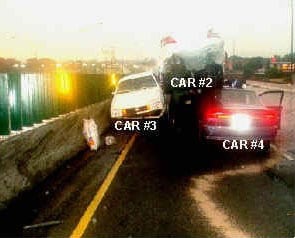 |
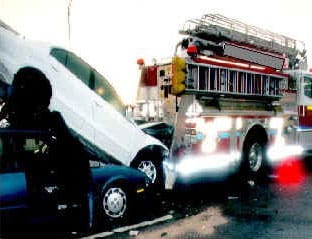 |
|
View from back of scene |
View of scene from side |
Photo 1 – Incident Scene
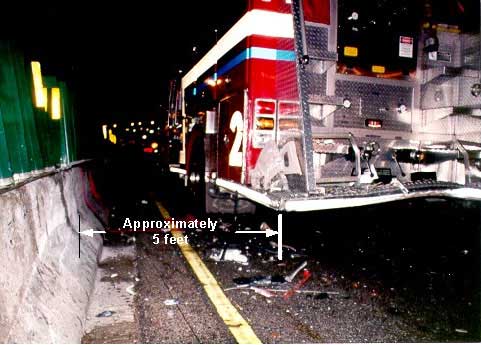
Photo 2 – Ladder 2 after vehicles were removed.
Note – Distance between median wall and Ladder 2 where car #3 was located is approximately 5 feet wide.
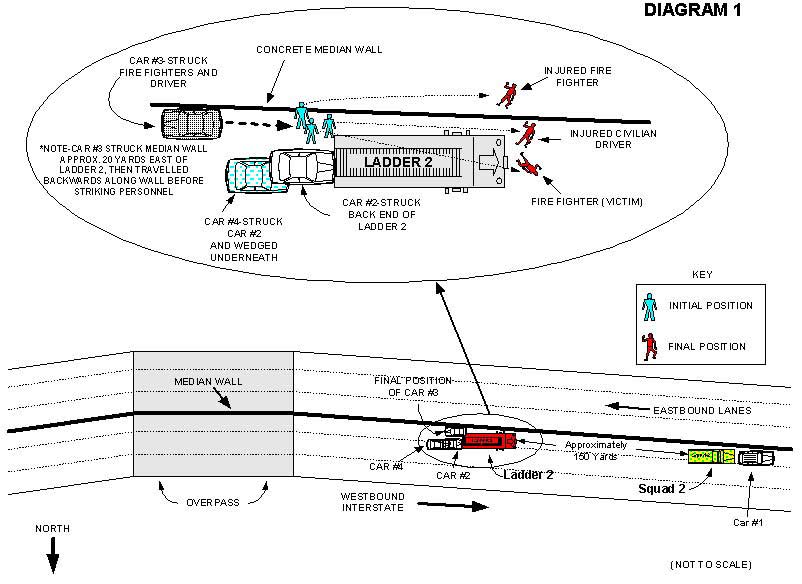
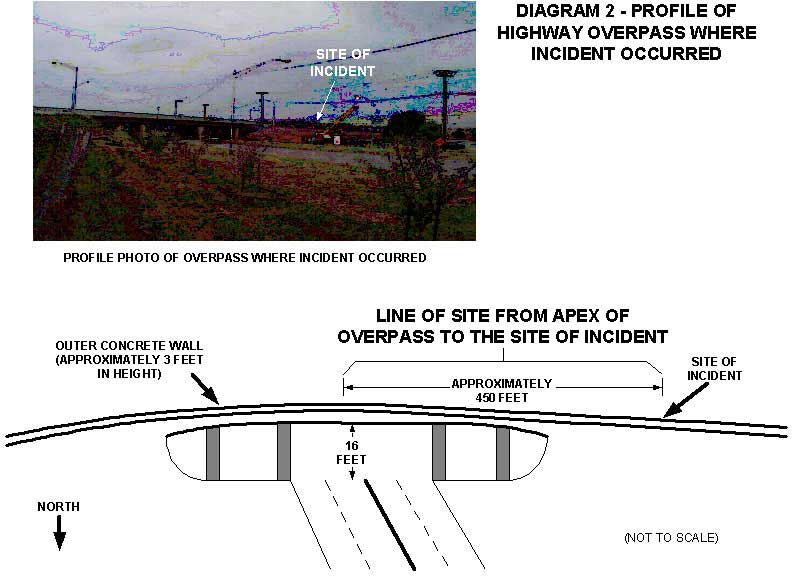
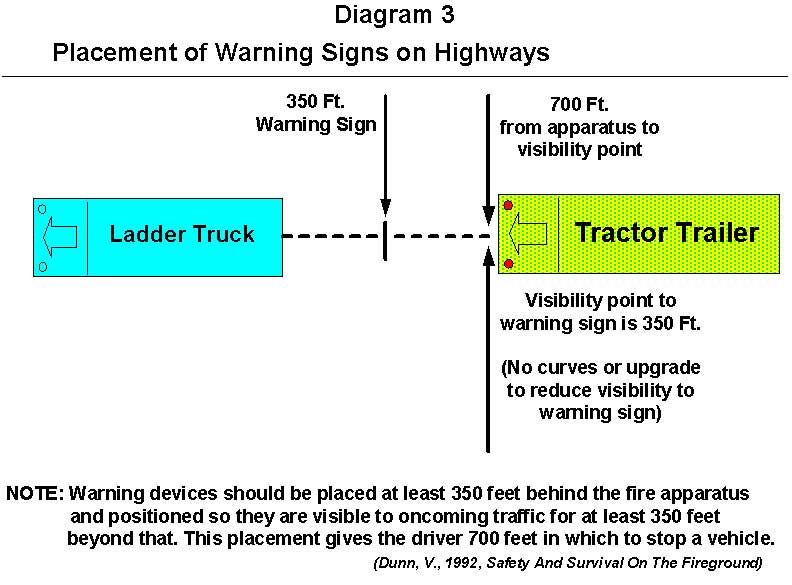
This page was last updated on 03/06/00
